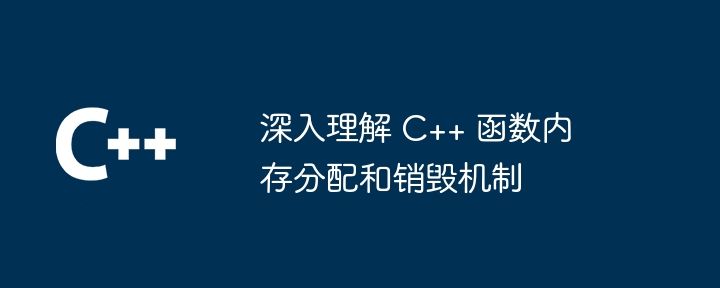
Function memory management involves automatic variables (stack allocation, released when the function returns) and dynamic allocation (heap allocation, using new, requiring manual release). The memory stack is expanded when a function is called, each call allocates its own memory, and the stack is withdrawn to the call point when released. The key to avoiding memory leaks is to ensure that dynamically allocated memory is always freed, such as using smart pointers or RAII.

In-depth understanding of C function memory allocation and destruction mechanism
Introduction
In In C, function calls involve memory allocation and destruction. Understanding these mechanisms is crucial as it helps us optimize code performance and prevent memory errors.
Automatic variables
Variables declared within a function are called automatic variables. They allocate memory on the stack when the function executes and release it when the function returns. The following are examples of automatic variables:
void myFunction() {
int n = 10; // 自动变量
// ...
}Dynamic allocation
Sometimes, it is necessary to allocate a larger object within a function than the stack allows. To do this, we can dynamically allocate memory on the heap using the new operator. Dynamically allocated objects survive after the function returns until freed using the delete operator.
void myFunction() {
int* p = new int(10); // 动态分配
// ...
delete p; // 释放分配的内存
}Function parameters
When a function accepts parameters, these parameters are allocated on the stack during the function call. The memory for function parameters is released after the function returns.
Merge
When a function calls another function, the memory stack will be expanded. Each function call allocates its own memory space on the stack. When the function completes, the memory is released and the stack is recalled to the point where the function was called.
Practical case – avoid memory leaks
The following is a practical case of function memory allocation and destruction mechanism:
void myFunction() {
int* p = new int(10); // 动态分配
if (condition) {
// 可能发生错误,导致 p 永远不会释放
}
}In this case, If condition is true, the p allocated memory will not be released, causing a memory leak. This is a common flaw in function memory allocation and destruction mechanisms.
To avoid memory leaks, it is important to always ensure that dynamically allocated memory is released in all cases, such as using smart pointers or RAII techniques.
The above is the detailed content of In-depth understanding of C++ function memory allocation and destruction mechanism. For more information, please follow other related articles on the PHP Chinese website!
 What are the differences between c++ and c language
What are the differences between c++ and c language
 Recommended learning order for c++ and python
Recommended learning order for c++ and python
 Cost-effectiveness analysis of learning python and c++
Cost-effectiveness analysis of learning python and c++
 Is c language the same as c++?
Is c language the same as c++?
 Which is better to learn first, c language or c++?
Which is better to learn first, c language or c++?
 The difference and connection between c language and c++
The difference and connection between c language and c++
 C++ software Chinese change tutorial
C++ software Chinese change tutorial
 Cost-effectiveness analysis of learning python, java and c++
Cost-effectiveness analysis of learning python, java and c++




